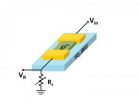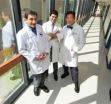(Press-News.org) Winter rains and summer groundwater pumping in California's Central Valley make the Sierra Nevada and Coast Ranges sink and rise by a few millimeters each year, creating stress on the state's earthquake faults that could increase the risk of a quake.
Gradual depletion of the Central Valley aquifer because of groundwater pumping also raises these mountain ranges by a similar amount each year – about the thickness of a dime – with a cumulative rise over the past 150 years of up to 15 centimeters (6 inches), according to calculations by a team of geophysicists.
While the seasonal changes in the Central Valley aquifer have not yet been firmly associated with any earthquakes, studies have shown that similar levels of periodic stress, such as that caused by the motions of the moon and sun, increase the number of microquakes on the San Andreas Fault, which runs parallel to the mountain ranges. If these subtle seasonal load changes are capable of influencing the occurrence of microquakes, it is possible that they can sometimes also trigger a larger event, said Roland Bürgmann, UC Berkeley professor of earth and planetary science at UC Berkeley.
"The stress is very small, much less than you need to build up stress on a fault toward an earthquake, but in some circumstances such small stress changes can be the straw that broke the camel's back; it could just give that extra push to get a fault to fail," Bürgmann said.
Bürgmann is a coauthor of a report published online this week by the journal Nature. The study, based on detailed global positioning satellite (GPS) measurements from California and Nevada between 2007 and 2010, was led by former UC Berkeley postdoctoral fellows Colin Amos, now at Western Washington University, and Pascal Audet, now of the University of Ottawa. The detailed GPS analysis was performed by William C. Hammond and Geoffrey Blewitt of the University of Nevada, Reno.
Draining of Central Valley
Water has been pumped from California's Central Valley for more than 150 years, reducing what used to be a marsh and extensive lake, Tulare Lake, into fertile agricultural fields that feed the world. In that time, approximately 160 cubic kilometers (40 cubic miles) of water was removed – the capacity of Lake Tahoe – dropping the water table in some areas more than 120 meters (400 feet) and the ground surface 5 meters (16 feet) or more.
The weight of water removed allowed the underlying crust or lithosphere to rise by so-called isostatic rebound, which has raised the Sierra probably as much as half a foot since about 1860, Bürgmann said.
The same rebound happens as a result of the state's seasonal rains. Torrential winter storms drop water and snow across the state, which eventually flow into Central Valley streams, reservoirs and underground aquifer, pushing down the crust and lowering the Sierra 1-3 millimeters. In the summer, water flow through the delta into the Pacific Ocean, evaporation and ground water pumping for irrigation, which has accelerated in the past few years because of a drought, allows the crust and surrounding mountains to rise again.
Bürgmann said that the flexing of Earth's crust downward in winter would clamp the San Andreas Fault tighter, lowering the risk of quakes, while in summer the upward flexure would relieve this clamping and perhaps increase the risk.
"The hazard is ever so slightly higher in the summer than in the wintertime," he said. "This suggests that climate and tectonics interact; that water changes ultimately affect the deeper Earth too."
High-resolution mapping with continuous GPS
Millimeter-precision measurements of elevation have been possible only in the last few years, with improved continuous GPS networks – part of the National Science Foundation-funded Plate Boundary Observatory, which operates 1,100 stations around the western U.S. – and satellite-based interferometric synthetic aperture radar (InSAR). These measurements revealed a steady yearly rise of the Sierra of 1-2 millimeters per year, which was initially ascribed to tectonic activity deep underground, even though the rate was unusually high, Bürgmann said. The new study provides an alternative and more reasonable explanation for the rise of the Sierra in historic times.
"The Coast Range is doing the same thing as the Sierra Nevada, which is part of the evidence that this can't be explained by tectonics," he said. "Both ranges have uplifted over the last few years and they both exhibit the same seasonal up and down movement in phase. This tells us that something has to be driving the system at a seasonal and long-term sense, and that has to be groundwater recharging and depletion."
In response to the current drought, about 30 cubic kilometers (7.5 cubic miles) of water were removed from Central Valley aquifers between 2003 and 2010, causing a rise of about 10 millimeters (2/5 inch) in the Sierra over that time.
After the new results were shared with colleagues, Bürgmann said, some geologists suggested that the state could get a better or at least comparable inventory of available water each year by using GPS to measure ground deformation instead of measuring snowpack and reservoir levels.
INFORMATION:
Other coauthors are Colin B. Amos of Western Washington University in Bellingham, Ingrid A. Johanson of UC Berkeley. Funding for the research came from NSF EarthScope and UC Berkeley's Miller Institute.
California mountains rise as groundwater depleted in state's Central Valley
Pumping for agriculture has raised Sierra Nevada mountain range 6 inches in 150 years
2014-05-14
ELSE PRESS RELEASES FROM THIS DATE:
CEBAF beam goes over the hump: Highest-energy beam ever delivered at Jefferson Lab
2014-05-14
The Continuous Electron Beam Accelerator Facility (CEBAF) at the U.S. Department of Energy's Thomas Jefferson National Accelerator Facility has achieved the final two accelerator commissioning milestones needed for approval to start experimental operations following its first major upgrade.
In the early hours of May 7, the machine delivered its highest-energy beams ever, 10.5 billion electron-volts (10.5 GeV) through the entire accelerator and up to the start of the beamline for its newest experimental complex, Hall D. Then, in the last minutes of the day on May 7, the ...
Who should be saved? Study gets diverse MD community views on healthcare disaster planning
2014-05-14
BALTIMORE—In the event of a flu pandemic, who should have priority access to life-saving ventilators, and who should make that determination? Few disaster preparedness plans have taken community values regarding allocation into account, but a new study is aiming to change that through public engagement with Maryland residents.
"In the event of a healthcare crisis, understanding the community perspective and having citizen buy-in will be critical to avoid compounding the initial disaster with further social upheaval," says principal investigator Elizabeth L. Daugherty ...
Strongly interacting electrons in wacky oxide synchronize to work like the brain
2014-05-14
Current computing is based on binary logic -- zeroes and ones -- also called Boolean computing, but a new type of computing architecture stores information in the frequencies and phases of periodic signals and could work more like the human brain using a fraction of the energy necessary for today's computers, according to a team of engineers.
Vanadium dioxide is called a "wacky oxide" because it transitions from a conducting metal to an insulating semiconductor and vice versa with the addition of a small amount of heat or electrical current. A device created by electrical ...
Research shows hope for normal heart function in children with fatal heart disease
2014-05-14
DETROIT, Mich., - After two decades of arduous research, a National Institutes of Health (NIH)-funded investigator at the Children's Hospital of Michigan (CHM) at the Detroit Medical Center (DMC) and the Wayne State University School of Medicine has published a new study showing that many children with an often fatal type of heart disease can recover "normal size and function" of damaged sections of their hearts.
The finding by Children's Hospital of Michigan's Pediatrician-in-Chief and Wayne State University Chair of Pediatrics Steven E. Lipshultz, M.D., F.A.A.P., F.A.H.A., ...
Study finds free fitness center-based exercise referral program not well utilized
2014-05-14
Eliminating financial barriers to a fitness center as well as providing physician support, a pleasant environment and trained fitness staff did not result in widespread membership activation or consistent attendance among low income, multi-ethnic women with chronic disease risk factors or diagnoses according to a new study from Boston University School of Medicine. The findings, published in Journal of Community Health, is believed to be the first study of its kind to examine patient characteristics associated with utilization of community health center- based exercise ...
Study finds outcome data in clinical trials reported inadequately, inconsistently
2014-05-14
Philadelphia, May 14, 2014 – There is increasing public pressure to report the results of all clinical trials to eliminate publication bias and improve public access. However, investigators using the World Health Organization's International Clinical Trials Registry Platform (ICTRP) to build a database of clinical trials involving chronic pain have encountered several challenges. They describe the perils and pitfalls of using the ICTRP and propose alternative strategies to improve clinical trials reporting. This important and insightful study is published in the August ...
Enzyme helps stem cells improve recovery from limb injuries
2014-05-14
AUGUSTA, Ga. – While it seems like restoring blood flow to an injured leg would be a good thing, it can actually cause additional damage that hinders recovery, researchers say.
Ischemia reperfusion injury affects nearly two million Americans annually with a wide variety of scenarios that temporarily impede blood flow – from traumatic limb injuries, to heart attacks, to donor organs, said Dr. Babak Baban, immunologist at the Medical College of Georgia and College of Dental Medicine at Georgia Regents University.
Restoring blood flow actually heightens inflammation ...
By itself, abundant shale gas unlikely to alter climate projections
2014-05-14
DURHAM, N.C. -- While natural gas can reduce greenhouse emissions when it is substituted for higher-emission energy sources, abundant shale gas is not likely to substantially alter total emissions without policies targeted at greenhouse gas reduction, a pair of Duke researchers find.
If natural gas is abundant and less expensive, it will encourage greater natural gas consumption and less of fuels such as coal, renewables and nuclear power. The net effect on the climate will depend on whether the greenhouse emissions from natural gas -- including carbon dioxide and methane ...
New smart coating could make oil-spill cleanup faster and more efficient
2014-05-14
In the wake of recent off-shore oil spills, and with the growing popularity of "fracking" — in which water is used to release oil and gas from shale — there's a need for easy, quick ways to separate oil and water. Now, scientists have developed coatings that can do just that. Their report on the materials, which also could stop surfaces from getting foggy and dirty, appears in ACS Applied Materials & Interfaces.
J.P.S. Badyal and colleagues point out that oil-spill cleanup crews often use absorbents, like clays, straw and wool to sop up oil, but these materials aren't ...
Advance brings 'hyperbolic metamaterials' closer to reality
2014-05-14
WEST LAFAYETTE, Ind. - Researchers have taken a step toward practical applications for "hyperbolic metamaterials," ultra-thin crystalline films that could bring optical advances including powerful microscopes, quantum computers and high-performance solar cells.
New developments are reminiscent of advances that ushered in silicon chip technology, said Alexandra Boltasseva, a Purdue University associate professor of electrical and computer engineering.
Optical metamaterials harness clouds of electrons called surface plasmons to manipulate and control light. However, some ...
LAST 30 PRESS RELEASES:
Heart-brain connection: international study reveals the role of the vagus nerve in keeping the heart young
Researchers identify Rb1 as a predictive biomarker for a new therapeutic strategy in some breast cancers
Survey reveals ethical gaps slowing AI adoption in pediatric surgery
Stimulant ADHD medications work differently than thought
AI overestimates how smart people are, according to HSE economists
HSE researchers create genome-wide map of quadruplexes
Scientists boost cell "powerhouses" to burn more calories
Automatic label checking: The missing step in making reliable medical AI
Low daily alcohol intake linked to 50% heightened mouth cancer risk in India
American Meteorological Society announces Rick Spinrad as 2026 President-Elect
Biomass-based carbon capture spotlighted in newly released global climate webinar recording
Illuminating invisible nano pollutants: advanced bioimaging tracks the full journey of emerging nanoscale contaminants in living systems
How does age affect recovery from spinal cord injury?
Novel AI tool offers prognosis for patients with head and neck cancer
Fathers’ microplastic exposure tied to their children’s metabolic problems
Research validates laboratory model for studying high-grade serous ovarian cancer
SIR 2026 delivers transformative breakthroughs in minimally invasive medicine to improve patient care
Stem Cell Reports most downloaded papers of 2025 highlight the breadth and impact of stem cell research
Oxford-led study estimates NHS spends around 3% of its primary and secondary care budget on the health impacts of heat and cold in England
A researcher’s long quest leads to a smart composite breakthrough
Urban wild bees act as “microbial sensors” of city health.
New study finds where you live affects recovery after a hip fracture
Forecasting the impact of fully automated vehicle adoption on US road traffic injuries
Alcohol-related hospitalizations from 2016 to 2022
Semaglutide and hospitalizations in patients with obesity and established cardiovascular disease
Researchers ‘listen in’ to embryo-mother interactions during implantation using a culture system replicating the womb lining
How changing your diet could help save the world
How to make AI truly scalable and reliable for real-time traffic assignment?
Beyond fragmented markets: A new framework for efficient and stable ride-pooling
Can shape priors make road perception more reliable for autonomous driving?
[Press-News.org] California mountains rise as groundwater depleted in state's Central ValleyPumping for agriculture has raised Sierra Nevada mountain range 6 inches in 150 years



